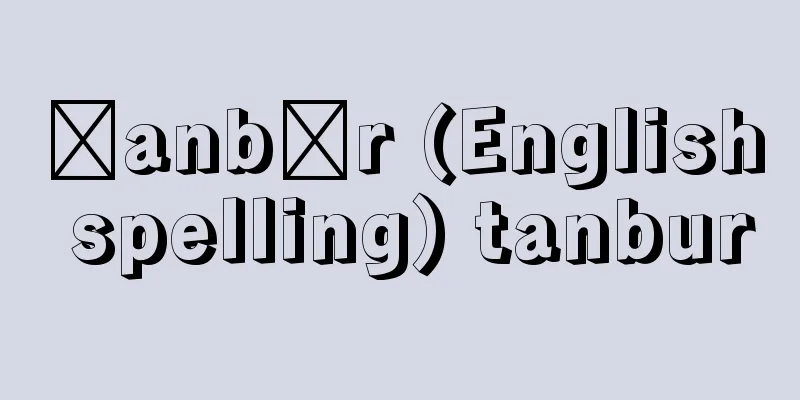Akaso - Akaso

|
A perennial plant of the Urticaceae family (APG classification: Urticaceae). It is named after the red stems and petioles. The stems grow in clusters of several and reach a height of 0.6-1.2 meters. They often split off near the middle. The leaves are long-stalked, opposite each other, rounded, and sharply tipped into three lobes. The edges are coarsely sawtoothed, and the surface is sparsely hairy but not noticeable. The inflorescences are separate, male and female, in the leaf axils. Both are spike-shaped, and the male inflorescences often split off at the bottom to become cone-shaped, with the male inflorescences growing in the middle of the stem and the female inflorescences growing in the upper part of the stem. It grows in the lowlands and mountains of the southern Kuril Islands, Hokkaido, and Kyushu, and is widely distributed in temperate East Asia outside of Japan. Diploids that reproduce sexually and triploids that produce seeds without fertilization are known, the latter being found throughout the species' distribution range, while the former is only found in the mountains on the Sea of Japan side of central Honshu. The closely related Kusakoakaso (grass small red hemp) B. gracilis CHWright differs from Akaso only in that its leaves do not have three lobes at the tip, and it has almost the same distribution range, but the sexually reproducing diploids are only found on the Pacific coast of central Honshu, in the mountains of Shikoku, and in the mountains of eastern mainland China, and there is a clear distinction between them and the closely related Akaso and Koakaso. These three species hybridize with each other, and the hybrids reproduce by ahymenatic seed formation, so it is difficult to distinguish them strictly morphologically. The Chinese name is Akaso. Another species with three-lobed leaves like Akaso is Meyabumao (female bush ramie), B. platanifolia (Maxim.) Franch. et Sav. ex CHWright, but this can be considered an intermediate form resulting from a cross between Akaso and Yabumao. It can be distinguished from Akaso by its larger, wider leaves and densely hairy surfaces. Only the form that forms apophytic seeds is known. The Chinese name for Kusakoakaso is Hosono-ma, and Meyabumao is called Hakkaku-ma. [Hiroshi Yonekura December 13, 2019] [References] | | | | | | | |©Kanzo Otawa "> Red and Black-streaked Solanum (Specimen Drawing) Source: Shogakukan Encyclopedia Nipponica About Encyclopedia Nipponica Information | Legend |
|
イラクサ科(APG分類:イラクサ科)の多年草。茎や葉柄が赤いのでこの名がついた。茎は数本固まって出て高さ0.6~1.2メートル。しばしば中部付近で枝を分ける。葉は長い柄(え)があって対生し、円形で先が鋭く3裂する特徴がある。縁(へり)には粗い鋸歯(きょし)があり、表面にはまばらに毛があるが目だたない。花序は葉腋(ようえき)について雌雄別となり、雌雄とも穂状か、雄花序はしばしば下部で短い枝を分けて円錐(えんすい)状となり、雄花序が茎の中部、雌花序が茎の上部から出る。南千島、北海道から九州の低地~山地に生育し、国外では東アジアの温帯に広く分布する。有性生殖を行う二倍体と受精しないで種子をつくる無融合種子形成を行う三倍体が知られ、後者は種の分布域全体にみられるが、前者は本州中部日本海側の山地にみられるだけである。近縁のクサコアカソ(草小赤麻)B. gracilis C.H.Wrightはアカソとは葉の先が3裂しない点でしか違わず、分布域もほぼ同じだが、有性生殖を行う二倍体は本州中部の太平洋側と四国の山地、飛んで中国大陸東部の山地のみに知られ、近縁のアカソやコアカソとは明瞭なすみ分けが認められる。これら3種は互いに交雑し、雑種が無融合種子形成を行って繁殖するため、形態的には厳密な区別はむずかしい。中国名は赤麻である。アカソ同様に葉が3裂する特徴をもつ種にメヤブマオ(雌藪真苧)B. platanifolia (Maxim.) Franch. et Sav. ex C.H.Wrightがあるが、これはアカソとヤブマオとの交雑に由来する中間型と考えることができる。アカソよりも葉が大きくて幅広く、表面に毛を密生する点で区別できる。無融合種子形成を行う型のみが知られる。クサコアカソの中国名は細野麻、メヤブマオは八角麻という。 [米倉浩司 2019年12月13日] [参照項目] | | | | | | | |©大多和鐘三"> アカソとコアカソ〔標本画〕 出典 小学館 日本大百科全書(ニッポニカ)日本大百科全書(ニッポニカ)について 情報 | 凡例 |
Recommend
Acanthodes
…The jaw structure of acanthognathic fishes has b...
Customary exclusive fishing rights - customary exclusive fishing rights
…The fishing rights system was established in the...
Khārq (island) (English spelling)
An island in the Persian Gulf 55 km off the coast ...
Via Flaminia (English spelling)
…It connected Beneventum and Brundisium, and serv...
Petauristinae
…A general term for small rodent mammals of the S...
Pieris japonica (Asebii)
An evergreen shrub of the Ericaceae family that gr...
Drowning Girl - Dekijo (English spelling) ni-nu
Refers to the killing of infants in China. The kil...
Rock Hagi - Iwahagi
Plant. A deciduous shrub of the Rubiaceae family, ...
Herodas (English spelling)
…An ancient Greek mimos poet active in the mid-3r...
Autobiography
A book written by a writer looking back on his or ...
Native Silver
...There are approximately 60 known minerals that...
Pleuronectidae
…General term for fish in the family Pleuronectid...
Publications of the Mathematical Society of Japan
…It has become one of the most popular magazines ...
texere
…An organic group of cells consisting of one or s...
Nuclear power industry
Industrial sectors related to the use and develop...









